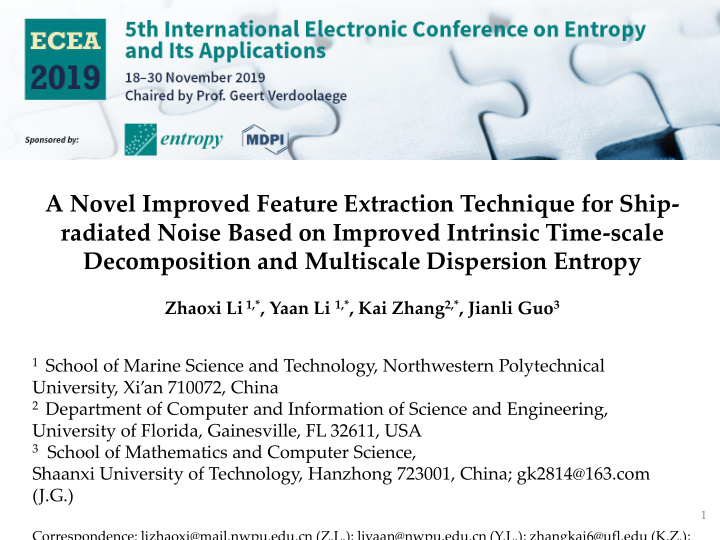



A Novel Improved Feature Extraction Technique for Ship- radiated Noise Based on Improved Intrinsic Time-scale Decomposition and Multiscale Dispersion Entropy Zhaoxi Li 1,* , Yaan Li 1,* , Kai Zhang 2,* , Jianli Guo 3 1 School of Marine Science and Technology, Northwestern Polytechnical University, Xi’an 710072, China 2 Department of Computer and Information of Science and Engineering, University of Florida, Gainesville, FL 32611, USA 3 School of Mathematics and Computer Science, Shaanxi University of Technology, Hanzhong 723001, China; gk2814@163.com (J.G.) 1 Correspondence: lizhaoxi@mail.nwpu.edu.cn (Z.L.); liyaan@nwpu.edu.cn (Y.L.); zhangkai6@ufl.edu (K.Z.);
Abstract: Entropy feature analysis is an important tool for classification and identification of different types of ships. In order to improve the limitations of traditional feature extraction of ship-radiation noise in complex marine environments, we proposed a novel feature extraction method for ship-radiated noise based on improved intrinsic time-scale decomposition (IITD) and multiscale dispersion entropy (MDE). The proposed feature extraction technique, named IITD- MDE. IITD as an improved algorithm has more reliable performance than instrinsic time-scale decomposition(ITD). Firstly, five types of ship-radiated noise signals are decomposed into a series of intrinsic scale component (ISCs) by IITD. Then, we select the ISC with main information through the correlation analysis, and calculate the MDE value as feature vector. Finally, input the feature vector into the support vector machine (SVM) classifier to analysis and get classification. The experimental results demonstrate that the recognition rate of the proposed technique reaches 86% of accuracy. Therefore, compare with the other feature extraction methods, the proposed method is able to classify the different types of ships effectively . Keywords: ship-radiated noise; dispersion entropy(DE); multiscale dispersion entropy(MDE); instrinsic time-scale decomposition(ITD); improved instrinsic time- scale decomposition(IITD); instrinsic scale component(ISC); feature extraction 2
Results and Discussion 1. Theory of IITD Becaues of ITD method uses a linear transformation method to obtain a baseline signal, it caused the waveform to appear the glitch and distortion. Therefore, in order to overcome this shortcoming, we proposes an IITD method that replaces the linear transformation in the ITD method with akima interpolation. Although akima interpolation is used, it is different from the envelop mean based on local extrema in EMD, because IITD only requires one akima interpolation per decomposition. 3
Baseline fitting method Figure 1. The comparsion of the interpolation methods: (a) linear interpolation, (b) cubic spline interpolation and (c) akima interpolation. 4
Intrinsic Scale Component (ISC) Figure 2. ISC satisfies the condition s
The IITD algorithm can be described as follow: = n ( ) + X ISC r t , t n n = 1 n ( ) Where is the intrinsic scale component (ISC), is a monotonic ISC nth r n t n trend signal.
2. Comparison between ITD and IITD Figure 3. Results of signal obtained by (a) ITD and (b) IITD
3. Theory of Multiscale Dispersion Entropy In order to overcome the incomplete problem of extracting the complexity of the signal in single-scale, we propose the MDE method. Coarse-grained process has better stability and advantage of feature extraction and error calculation of the signal. Figure 4 shows the coarse-grained process. Figure 4. Coarse-grained process
Under each scale factor, the dispersion entropy of each coarse-grained signal can be calculated by ( ) ( ) ( ) = MDE x , m , c , d , DE x , m , c , d
4. Experimental Verification and Ananlysis In order to demonstrate the effectiveness of feature extraction method based on IITD and MDE, all data we used are actual ship-radiated noise signals under the same conditions. Five different types of ship-radiated noise signals are selected as sample data, namely ferry ship, cruise ship, passenager ship, submarine and oceanline. For convenience, we respectively name the five ship-radiated noise signals as Ship-A, Ship-B, Ship-C, Ship-D and Ship-E. The sample rate of Ship-A, Ship-B and Ship-D are 44.1kHz. The sample rate of Ship-C and Ship-E are 52734Hz. The time domain waveforms are shown as follows:
Feature extraction of ship-radiated noise (a) IITD-MDE (b) ITD-MDE
Ship Classification (a) The proposed method (b) The ITD-MDE method Methods Accuracy Rate The proposed method 86% The ITD-MDE method 74%
Conclusions To improve the recognition accuracy of ship-radiated noise signals, a novel feature extraction method based on IITD and MDE is proposed. The main contribution of this paper are highlighted as follows: (1)An improved ITD algorithm for ship-radiated noise signal is put forward for the first time in this paper. (2)A novel feature extraction algorithm is proposed using IITD and MDE for ship- radiated noise signal in the field of underwater acoustic signal processing. (3)We compared with IITD and ITD to simulate and experiments. It is found that IITD overcomes the defect of waveform distortion caused by the ITD method using linear transform to calculate the baseline signal. So , IITD algorithm is better to extract the baseline signal. (4)We conduct the simulation experiments to demonstrate that MDE has the advantage of DE, which results in more robust when dealing with noisy signals. Therefore, we applied the MDE method to underwater acoustic signal processing. (5)We compare with other extract feature method, IITD-MDE is more precisely and comprehensively to extract the characteristics of ship-radiated noise signal. The classification recognition rate for five types of ship-radiated noise signals is 86%. 14
Thank you!
Recommend
More recommend